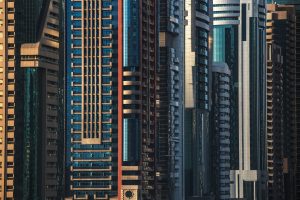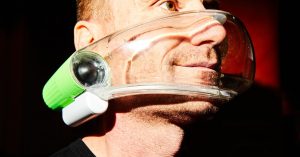When photographers show their work to us WIRED photo editors, common responses as to why they’re reluctant to show off some of their most interesting projects include “I wasn’t sure if this is WIRED’s style,” or “I didn’t think you cover this.”
Year in Review: What WIRED learned from tech, science, culture, and more in 2019
Sure, we feature some obvious technological subjects, like the optical fibers bringing 5G online. And it’s no secret we rely on certain techniques (hint: hard light and bold shadows). But, as our editor in chief Nicholas Thompson likes to say, WIRED isn’t simply a publication about technology; it’s a magazine about change. That change manifests in myriad forms and is documented by a diverse spectrum of photography, sometimes over the span of years. Here, writers Laura Mallonee and Michael Hardy highlight some of their favorite projects and image-makers from 2019.
It’s easy to find shocking photos of slaughterhouses online. Nikita Teryoshin’s Hornless Heritage has a similar effect, minus the gore. His bright flash illuminates the utilitarian calculation of an industry where cows are commodities, and treated as such. At least, it made me lose my appetite. —Laura Mallonee
If you taught marine biology in the 19th century and needed teaching aids, you wrote to father-and-son glassworkers Leopold and Rudolf Blaschka, who created thousands of dazzlingly lifelike models of jellyfish and other invertebrates in their Dresden studio. Shipped all over the world, hundreds of the glass models still survive in university museums. Guido Mocafico recently spent several years traveling around Europe to photograph the models, lighting them so they looked as realistic as possible. It worked—some viewers believe they’re looking at actual sea creatures. —Michael Hardy
Few women see their own uteruses post-hysterectomy, much less photograph them. Elinor Carucci nearly passed out while doing so. That bravery (obstinance?) reverberates through Midlife, an unprecedented look at aging and corporeal loss that resonates for women, of course, and with anyone else alike. —Laura Mallonee
Women make up 40 percent of all athletes but receive just 4 percent of all sports-related coverage. It’s backward and dumb, and Alana Paterson is doing her part to change it. I was inspired by her high-contrast photos of young hockey players whizzing across the ice, part of a larger body of work spotlighting underrepresented—and often underpaid—female athletes. —Laura Mallonee
This image was captured near Interstate 79 in Elkview, West Virginia, after a series of floods had passed through the area.
Photograph: Joshua Dudley GreerThe highway is an iconic symbol of American freedom. But it’s also a drab backdrop for countless soul-wearying commutes and thousands of traffic deaths. Joshua Dudley Greer captures this friction in Somewhere Across This Line, a 100,000-mile odyssey through the interstate system. —Laura Mallonee
In the centuries-old Central Asian sport of buzkashi, several dozen horseback riders fight to throw a disemboweled goat or calf carcass into a ring or other designated area. With no teams, no clock, and no clearly defined playing field, it’s one of the world’s wildest sports. Anna Huix traveled to Tajikistan specifically to photograph a buzkashi match, and masterfully captured the tradition’s pageantry and mayhem. —Laura Mallonee
Skate parks have become a defining feature of Southern California’s built environment. Although sometimes dismissed as eyesores, Los Angeles photographer Amir Zaki finds the beauty in the parks’ sculpted concrete bowls and plateaus, which for him evoke the work of Land Art pioneer Michael Heizer. Zaki photographed the parks early in the morning, before any skaters had arrived, to better capture their austere grandeur. —Michael Hardy
Wistman’s Wood in southwestern England has long inspired stories of the supernatural, serving as a setting for Arthur Conan Doyle’s The Hound of the Baskervilles and an inspiration for Fangorn Forest in The Lord of the Rings. Photographer Neil Burnell visited the woods as a child, and over the past few years has made some 20 trips there in an attempt to capture its otherworldly beauty. These images were mostly taken during the “blue hour” just before sunrise, and although they may look computer-generated, they’re very real. —Michael Hardy
Melting sea ice may be bad for polar bears, but it’s good for Russian oil and gas tycoons eager to tap the Arctic’s resources. Charles Xelot’s epic photographs take you to the frontier where they’re drilling for fossil fuels, and shipping it via the Northeast Passage—occasionally getting stuck. —Laura Mallonee
The photographer and urban explorer known as Jonk has managed to sneak into some 1,500 abandoned buildings around the world, but none was as difficult to access—or as worthwhile—as the Baikonur Cosmodrome in Kazakhstan. Jonk and three friends had to hike all night through the desert to access the active spaceport, but they were rewarded with the opportunity to photograph two abandoned Soviet space shuttles currently rusting away in a hangar. Jonk and his buddies spent two full days exploring the site before reluctantly heading back to the real world. —Michael Hardy
Go here to check out what else caught our collective eyes this year.
More Great WIRED Stories
- The war vet, the dating site, and the phone call from hell
- Room to breathe: My quest to clean up my home’s filthy air
- Why the “queen of shitty robots” renounced her crown
- Amazon, Google, Microsoft—who has the greenest cloud?
- Everything you need to know about influencers
- 👁 Will AI as a field “hit the wall” soon? Plus, the latest news on artificial intelligence
- 🏃🏽♀️ Want the best tools to get healthy? Check out our Gear team’s picks for the best fitness trackers, running gear (including shoes and socks), and best headphones.



